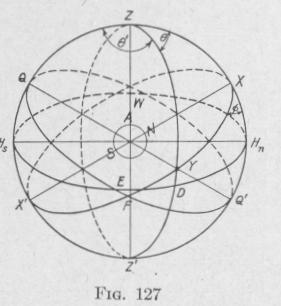CHAPTER V
NAVIGATIONAL COMPASSES
§1. The Various Types
98. The Altitude Azimuth Method of Locating the Geographic Meridian.-From the known position of a celestial body, together with simple astronomical observations, the direction of the true north at the place of observation can be determined. Accurately predicted positions of various celestial bodies as well as the times at which certain celestial phenomena will occur are given in Nautical Almanacs published annually by the governments of our maritime nations. Useful tables and all the standard methods of determining navigational quantities are given in Bowditch's American Practical Navigator published by the Hydrographic Office of the U. S. Navy.
The geographic meridian of a place on the earth is the great circle of the earth that passes through the given place and the poles of the earth. This line is in the true north-south direction at the given place. The line in the direction of the horizontal component of the magnetic field of the earth at any given place is called the magnetic meridian at that place. At very few places is the magnetic meridian in the plane of the geographic meridian. A magnetic needle unaffected by any force except that due to the earth's magnetic field sets itself in the plane of the magnetic meridian at the given place. The compass bearing of any object is the angle at the center of the compass card between the magnetic axis of the compass needles and the straight line from the center of the card to the given object.
A celestial body may be located by two quantities. There are three pairs of such quantities commonly employed to locate an object in the sky. They are called altitude and azimuth, declination and right ascension, celestial latitude and celestial longitude.
The celestial sphere is an imaginary sphere of infinite radius onto which, to an observer on the earth, the celestial bodies appear to be projected. Figure 127 represents the celestial sphere, drawn as though it were of finite radius. The small circle represents the
THE VARIOUS TYPES 163
earth with the poles marked N and S, respectively. The celestial poles are the points (XX') at which the prolongation of the earth's axis NS intersects the celestial sphere. The celestial equator or equinoctial is the great circle (QEQ'W) formed by the intersection of the celestial sphere and the plane of the earth's equator. The great circle II„EHSW is the celestial horizon for an observer at A. The celestial meridian, declination circle, or hour circle of any celestial body Y is the great circle of the celestial sphere (X YX') passing through the given body and the celestial poles. The
celestial meridian of the place A on the earth is ZXQ'X'Q. The point Z at which a vertical line from a place A on the earth intersects the celestial sphere is called the zenith of the given place. The half of a celestial meridian which lies on the same side of the equinoctial as the zenith is called the upper branch; the other half is called the lower branch.
At a given place A, the polar
angle or hour angle of a celestial
body Y is the angle ¢ at the celestial poles between the meridian of the place and the meridian of the celestial body. The azimuth or true bearing of a celestial body Y is the angle between the meridian of the observer at A and the vertical great circle passing through the body. In Fig. 127 the azimuth 0' of the body Y measured from the north is X'Z Y, while measured from the south it is X'Z' Y. Azimuths are to be reckoned from the north in north latitudes and from the south in south latitudes. The altitude of any body is its angular distance YD (or angle YAD) from the horizon of the observer, measured upon the vertical great circle through the given body. The zenith distance of a body is its angular distance YZ (or angle YAZ) from the zenith, measured on the vertical great circle through the body. Zenith distance is the complement of the altitude. The declination of a body Y is its angular distance FY (or angle FAY) from the equinoctial, measured on the celestial meridian of the given body. It is designated as north (+) or south (-), according to the direction of the body from the equinoctial. The polar distance of a celestial body
Y is its angular distance VY (or nnalp V A Y) frnm +ha n-lo --
